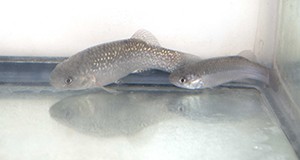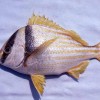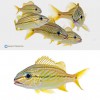
The Gulf killifish is a promising species for commercial aquaculture in Florida with the potential to help diversify the marine baitfish aquaculture industry in Florida and throughout the southeastern United States. Methods for culturing this species have improved in the past decade; this 6-page fact sheet describes the new methods and some strategies to give producers greater control of reproduction, larval growth, and survival. The publication provides the information producers need to make the most informed decision possible when considering Gulf killifish aquaculture. Written by Shane W. Ramee, Joshua T. Patterson, Cortney L. Ohs, and Matthew A. DiMaggio and published by the Program in Fisheries and Aquatic Sciences, School of Forest Resources and Conservation.
http://edis.ifas.ufl.edu/fa190
Tag: Candidate Species for Florida Aquaculture series
Candidate Species for Marine Ornamental Aquaculture: Porkfish, Anisotremis virginicus
 The porkfish is a member of the grunt family, which create a characteristic “grunting” sound by rubbing their pharyngeal teeth together during periods of agitation or courtship. Many species of grunts are popular in public aquariums because they’re abundantly available, and their schooling behavior and bright colors create interest in aquarium exhibits. Porkfish also have additional appeal to aquarists because they are “cleaner” fish during their juvenile phase, picking parasites from larger fish and other vertebrates. Scientists and aquarists have recently achieved a greater understanding of appropriate aquaculture protocols for grunts in general and porkfish in particular. These characteristics and advancements have led to porkfish being identified as a candidate species for commercial aquaculture. This 5-page fact sheet was written by Eric Cassiano and Kevin Barden, and published by the UF Department of Fisheries and Aquatic Sciences, October 2014. (Photo by George H. Burgess, Florida Museum of Natural History)
The porkfish is a member of the grunt family, which create a characteristic “grunting” sound by rubbing their pharyngeal teeth together during periods of agitation or courtship. Many species of grunts are popular in public aquariums because they’re abundantly available, and their schooling behavior and bright colors create interest in aquarium exhibits. Porkfish also have additional appeal to aquarists because they are “cleaner” fish during their juvenile phase, picking parasites from larger fish and other vertebrates. Scientists and aquarists have recently achieved a greater understanding of appropriate aquaculture protocols for grunts in general and porkfish in particular. These characteristics and advancements have led to porkfish being identified as a candidate species for commercial aquaculture. This 5-page fact sheet was written by Eric Cassiano and Kevin Barden, and published by the UF Department of Fisheries and Aquatic Sciences, October 2014. (Photo by George H. Burgess, Florida Museum of Natural History)
http://edis.ifas.ufl.edu/fa187
Candidate Species for Marine Ornamental Aquaculture: French Grunt, Haemulon flavolineatum
 Grunts (family Haemulidae) are some of the most economically and ecologically important fishes found throughout the world. Their common name refers to the characteristic grunting sound they make when they are agitated and during courtship. Many species of grunts are popular in public and private aquariums due to their schooling behavior and bright colors that create interest in aquarium exhibits. The French grunt has recently been identified as a candidate species for aquaculture due to its popularity in aquarium displays and the development of culture protocols. This 4-page fact sheet was written by Kevin P. Barden, Matthew L. Wittenrich, and Eric J. Cassiano, and published by the UF Department of Fisheries and Aquatic Sciences, March 2014.
Grunts (family Haemulidae) are some of the most economically and ecologically important fishes found throughout the world. Their common name refers to the characteristic grunting sound they make when they are agitated and during courtship. Many species of grunts are popular in public and private aquariums due to their schooling behavior and bright colors that create interest in aquarium exhibits. The French grunt has recently been identified as a candidate species for aquaculture due to its popularity in aquarium displays and the development of culture protocols. This 4-page fact sheet was written by Kevin P. Barden, Matthew L. Wittenrich, and Eric J. Cassiano, and published by the UF Department of Fisheries and Aquatic Sciences, March 2014.
http://edis.ifas.ufl.edu/fa186
FA160 Candidate Species for Florida Aquaculture: Pigfish, Orthropristis chrysoptera
FA160, a six-page illustrated fact sheet by Eric J. Cassiano, Cortney L. Ohs, and Jeff E. Hill, describes this member of the grunt family that is rated as a top species for baitfish aquaculture — general description, geographic distribution and habitat, natural history, and culture techniques. Includes references. Published by the UF School of Forest Resources and Conservation Program in Fisheries and Aquatic Sciences, December 2009.
http://edis.ifas.ufl.edu/fa160
FA166 Candidate Species for Florida Aquaculture: Discus Symphysodon spp., a Profitable but Challenging Species for Florida Aquaculture
FA166, an 8-page illustrated fact sheet by E. J. Livengood, C. L. Ohs, and F. A. Chapman, provides an overview of this disc-shaped freshwater chiclid fish — description, habitat and feeding, conservation issues, taxonomy, genetics and domestication, culture methods, and markets. Includes references. Published by the UF Program in Fisheries and Aquatic Sciences, School of Forest Resources and Conservation, December 2009.
http://edis.ifas.ufl.edu/fa166